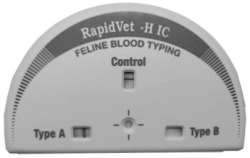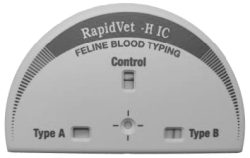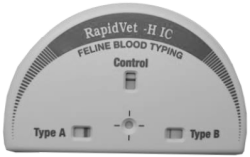RapidVet-H IC Feline
This page contains information on RapidVet-H IC Feline for veterinary use.The information provided typically includes the following:
- RapidVet-H IC Feline Indications
- Warnings and cautions for RapidVet-H IC Feline
- Direction and dosage information for RapidVet-H IC Feline
RapidVet-H IC Feline
This treatment applies to the following species:ImmunoChromatographic Test
For Identifying Feline A, B and AB Blood
For in vitro use
COMPONENTS & PROCEDURE HAVE CHANGED!
Eff. August 18, 2022
REVIEW PACKAGE INSERT BEFORE TESTING!
Description and Intended Use: RapidVet-H IC Feline Blood Typing System is intended for use to classify cats as blood group Type A, Type B or Type AB.
The importance of identifying blood groups in cats has increased in recent years, particularly in transfusion medicine, because only by predetermining the blood type of the donor and recipient can potentially fatal transfusion mistakes be avoided.
One blood group system consisting of two antigens expressed either alone or in combination has been described in cats: Type A, Type B and Type AB. The antigens are unrelated to human A B O antigens and are defined by feline alloimmune sera. Blood group incidence varies among breeds.
Blood groups in cats are inherited as simple autosomal traits, with Type A being dominant. Most cats possess the A antigen, and about one-third of those have naturally occurring, low-titered anti-B antibody. Type B cats all have a naturally occurring, high-titered anti-A antibody. Type AB cats are rare and have no naturally occurring antibodies to either Type A or Type B antigens; however, it is the prevailing recommendation that if an AB donor is not available, these cats receive Type A packed red blood cells. The Association of Veterinary Hematology and Transfusion Medicine (AVHTM) Transfusion Reaction Small Animal Consensus Statement (TRACS) recommends that major crossmatching be performed in addition to blood typing prior to the first transfusion in cats.1
Principle and Explanation of the Assay: RapidVet-H IC Feline Blood Typing System uses immunochromatographic (lateral flow) technology. The system, uses a feline blood sample and consists of a test device containing three membranes, and is dependent upon the use of a microtube containing pre-measured diluent specific for this feline test. The diluent facilitates movement of the red cells along the membranes. It is a cell capture assay and, as such, patients exhibiting auto-agglutination or low PCV can be typed with this system.
Each membrane contains, in a sharply defined area, a substance that captures red blood cells under only one set of conditions. The membranes intersect under the round central port. When dispensed into the central port, the diluted blood migrates to specific binding points on the membranes and becomes visible in the appropriate window(s) on the device.
The membrane under the viewing window labeled “Control” contains a substance that captures all cells. This window should display a horizontal red line to indicate the test has performed properly.
The second membrane contains a monoclonal antibody for feline Type A red blood cells that will capture corresponding red blood cells in a vertical line in the viewing window labeled “Type A.”
The third membrane contains a reagent that will capture feline Type B red blood cells in a vertical line in the viewing window labeled “Type B.”
Reagents and Materials: RapidVet-H IC test kits contain:
IC Test Devices (in sealed, foil pouch)
Blood Prep Tubes (pre-filled, feline IC test-specific)
Capillary Pipettes (20 µL)
Dispensing Pipettes (40 µL)
Blood Group Report Cards
Package Insert
Materials Required But Not Provided: None
Reagent Preparation: None
Sample: Whole blood with EDTA anticoagulant, fresh or stored in the refrigerator for no longer than 5 days. Refer to Step 3 for use of packed cells.
Storage and Stability: Stable at room temperature (18-25°C/65-77°F) for 12 months from date of shipment. Each test is labeled with an expiration date. DO NOT FREEZE.
NEW PROCEDURE - PLEASE READ CAREFULLY:
1. Remove 1 report card and 1 plastic bag from the box. Each bag contains: 1 sealed test device, 1 capillary pipette (20 µL), 1 dispensing pipette (40 µL) and 1 pre-filled Blood Prep tube.
2. Open the sealed foil pouch and remove the device. Write the patient name on the front of the device. Place the device on a flat surface to run the test.
3. Obtain EDTA anticoagulated whole blood sample. The collection tube or syringe should be filled to ensure a proper concentration of EDTA. (If packed cells are used, they must be diluted 1:1 with saline before proceeding to Step 4.)
4. Using the supplied 20 µL capillary pipette, prepare a blood dilution by pipetting 1 drop of blood into the pre-filled Blood Prep tube. Replace the cap and gently invert several times to mix.
5. Uncap the Blood Prep tube and use the supplied 40 µL dispensing pipette to put 9 drops of the diluted blood into the central, round unmarked port. Remember to keep the pipette perpendicular to the device when dispensing drops.
6. Allow the device to rest on the flat surface. Result lines may be visible in less than 5 minutes, but a full 5 minutes should be allowed for the test. The results must be read in no more than 10 minutes. See Limitations of Procedure below.
Record patient results on provided Blood Group Report Card as the device results will fade.
Results: A positive result is represented by the formation of a vertical red line.
Along with visible result line(s), the Control window must display a horizontal red line to indicate the test has performed properly. See Limitations below.
|
Vertical line forms in only the “Type A” window, the cat has blood group A |
 |
|
Vertical line forms in only the “Type B” window, the cat has blood group B |
 |
|
Vertical lines form in both the “Type A” and the “Type B” windows, the cat has blood group AB Note: Since Type AB is rare, it is currently the predominant view that all AB results should be confirmed by “back-typing.” |
 |
Limitations of the Procedure:
Use diluted blood immediately as the diluent has a hemolytic effect on the blood. The diluted blood cannot be made in advance or reused.
Samples exhibiting clots or hemolysis should not be used.
The fluid components provided with this kit must be used and are not interchangeable with previous versions of this test, or with other blood typing tests.
Incomplete Line(s) in Viewing Windows: Occasionally the line(s) in the viewing windows (A, B and/or Control) may be incomplete within the time period of the test. This still represents a correct result.
Performance Characteristics: An independent clinical study2 on blood samples from 89 sick and 16 healthy cats compared an earlier version of RapidVet-H IC with two reference methods: a gel column test considered to be the “gold standard” and a tube agglutination method. The reference methods agreed with each other 100% and determined the samples to be from 85 type A, 17 type B and 3 AB cats. Of the 85 type A samples, 80 were correctly identified by the IC test, four were misidentified as AB and one was rated inconclusive. All B samples were correctly typed. Two of the three AB samples were correctly identified by the IC test and one was rated inconclusive. The agreement of the RapidVet-H IC test with the reference methods was 96.1% and the IC test showed high sensitivity and specificity for A and B antigen detection.
An in-house evaluation using the current version (Rel.5.0/2022) of RapidVet-H IC tested blood samples from 82 cats (68 type A, 6 type B and 8 type AB) and compared the results to the card test or to a tube agglutination test performed by an outside laboratory. In addition, repeatability and reproducibility studies were conducted using 7 feline samples in 5 replicates. All IC results were obtained in less than 5 minutes. The accuracy, specificity and sensitivity of the tests were 100%.
Quality Control: All reagents and materials incorporated into this kit have been quality controlled by standard testing procedures using a routine quality control program during manufacture.
Disposal
Dispose of all biological materials, test devices, pipettes and tubes in a biohazard container.Manufactured for dmslaboratories,inc. by Agrolabo SpA
RapidVet is a registered trademark of dmslaboratories, inc.
1.AVHTM TRACS Part 2, Section 3.7.1.b and 3.7.2
2.Hourani, L., Weingart, C., & Kohn, B. (2014). Evaluation of a novel feline AB blood typing device. Journal of Feline Medicine and Surgery, Vol. 16(10), 826-831.
HFIC-002
dmslaboratories, inc, 2 Darts Mill Road, Flemington, NJ 08822
Tel: (908) 782-3353 / (800) 567-4367
Technical Support: (888) VET-TEST
Fax: (908) 782-0832
www.rapidvet.com
Rev. 08/25/22 HFICv5
Presentation: Boxes of 2, 5 or 10 tests.
CPN: 1481012.5
2 DARTS MILL ROAD, FLEMINGTON, NJ, 08822
| Telephone: | 908-782-3353 | |
| Toll-Free: | 800-567-4367 | |
| Order Desk: | 800-567-4367 | |
| Technical Service: | 888-VET-TEST (838-8378) | |
| Fax: | 908-782-0832 | |
| Website: | www.rapidvet.com | |
| Email: | dms@rapidvet.com |
 |
THIS SERVICE AND DATA ARE PROVIDED "AS IS". DVMetrics assumes no liability, and each user assumes full risk, responsibility, and liability, related to its use of the DVMetrics service and data. See the Terms of Use for further details. |
Copyright © 2024 Animalytix LLC. Updated: 2024-02-27
